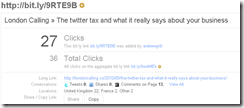One of the limitations of twitter is that if you want to share a website link such as /2010/10/using-your-own-branded-short-urls-on-twitter-part-1 then the link actually takes up a number of valuable characters (83 to be exact) – more than half of the 140 available in a single tweet.
The answer of course is to use one of a number of URL shorteners that have started to appear.
One of the first was tinyurl.com which was launched back in 2002. In fact twitter started using tinyurl to automatically shorten long URLs until 2009 when they switched to one of the leaders in this space – bit.ly
If you spend more than a few minutes on twitter every day you will see bit.ly links scroll up the screen as your followers share links they are interested in.

bit.ly is great and offers a wide range of statistics on who clicked on the short link and when and where they are etc
[TOP TIP] You may not know that you can check on these stats yourself for any bit.ly link by adding a “+” to the end of the bit.ly link eg http://bit.ly/ad2020+ gives you more about how many have clicked on the link and from where etc.

One of the problems with public URL shorteners is that you are at the mercy of the provider to keep the service running, and you also have to use their brand in the link.
If however you wanted to use your own website domain as a URL shortener, you will run into a couple of other problems.
The first is the IT department who won’t want you going anywhere near the website, and the second is that your company website domain name is possibly already too long to be sensibly used as a URL shortener.
The solution is to buy a short domain that reflects in some way your company’s branding and run your own service on this URL.
Recent examples of branded short URLs I have come across include
Wunderman wndr.mn
BBC bbc.in
The Independent ind.pn
Coke cokeurl.com
Reuters news reut.rs
as well as some other bloggers & Journalists
Tim Bradshaw from the FT tim.lc
Robert Brook rb.tlMalcolm Coles mcol.es
Stephen Waddington wadds.co
You may have noticed that I use lc.tl (short of course for London Calling) on all of my twitter links, and it also appears as the link on my twitter Bio that goes straight to LondonCalling.co
In a recent post, Stephen Waddington (@wadds) mused if short URLS are “geek chic or the social media equivalent of personalised car number plates?”
On the strength of it, Wadd’s question is valid, but personalised URLs provide much more value in the hands of brands than bloggers.
Having seen the benefits of my own shortURL service, I am now advising clients to set up their own rather than using bitly and I am also managing the service for some of them – with full statistics and analytics (just like bit.ly) all from my own lc.tl domain.
To set up the service behind lc.tl, I deployed an excellent open source URL shortener from Ozh Richard (@ozh) called Yourls. In short – it is perfect.
You can also read a longer post on how Vodafone and Virgin utilise YOURLS here.
In part 2 of this post, I will look at how you actually go about setting one of these up, as well as the pros and the cons of various providers and my experience with using Yourls to date.
Head to part 2 now to see how you can set up YOURLs yourself with your own domain.

